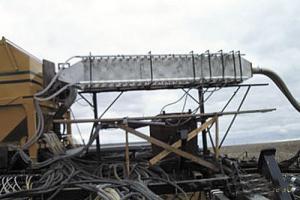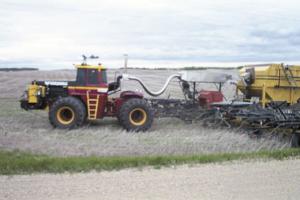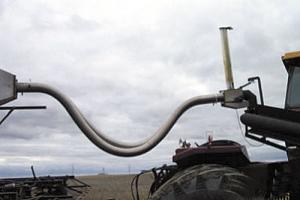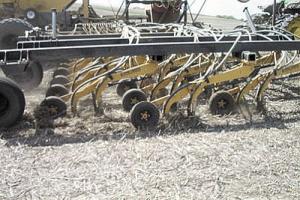2006 - Volume #30, Issue #5, Page #04
[ Sample Stories From This Issue | List of All Stories In This Issue | Print this story
| Read this issue]
They're Turning Tractors Into Mobile Fertilizer Plants
 |
 |
 |
 |
"The goal is to reduce the amount of fertilizer needed to grow a crop," says Carlisle. "At the same time we hope to lower harmful greenhouse gas emissions."
He has been working with Gary Lewis of Cowley, Alberta, who invented the system and hopes to patent the process. Carlisle is one of nine farmers in Canada who are testing the equipment. He says crops grown with just engine exhaust yield as well as conventionally-fertilized crops and, in some cases, even better.
The secret is the carbon dioxide in the exhaust. Lewis notes that the same idea is often used in greenhouses where carbon dioxide is pumped in to stimulate growth.
Exhaust is routed from the muffler to a 14-ft. long, 2 by 2-ft. cooling chamber behind the tractor. The air seeder's fan forces it down through the same hoses that deliver seed and fertilizer to the ground. "A big challenge is figuring out how to sufficiently cool that exhaust," he says. "The exhaust comes off the tractor at about 1,000 degrees, and we have to get it down to about 150 degrees so it won't melt hoses and pipes.
"When people first hear about what we're doing they're blown away by the idea and don't take it seriously. But when I talked to a Cummins rep about this idea he just smiled, because the company knows what's coming out of the exhaust. Fertilizer companies don't want to see this."
Carlisle uses a Seedmaster 60-ft. air seeder with 12-in. spacings, and pulls it with a Deere 9520 tractor equipped with a 450 hp diesel engine.
"We're now collecting data to evaluate the system. Dr. Lorraine Bailey of Brandon, Manitoba, is helping us make sense of it," says Carlisle.
"We stopped using nitrogen, and instead have only been top dressing foliar fertilizer. Normally we would put down about 100 lbs. of nitrogen during planting, but now we apply only 12 lbs. including the top dressing application. We've tested this idea on several different crops including peas, wheat, oats, canola, soybeans, and potatoes. We take tissue samples every 10 to 14 days.
"We know that adding carbon to the soil enhances plant growth. We just can't provide the exact numbers yet. We're not saying you can cut out all fertilizer but you can definitely reduce it. A lot of farmers are looking at the benefit of adding carbon dioxide even if they aren't able to save money on fertilizer. A lot of foliar and micronutrient packages, such as Humic acids, calcium carbonate micronutrients, now include a carbon-based product."
The equipment for the current system would probably cost about $30,000. "We think a grower with 1,000 to 1,500 acres could save up to $30 per acre so the equipment would pay for itself quickly," says Carlisle.
"The biggest advantage is that we're increasing microbial activity in the soil dramatically, which helps break down nutrients," says Carlisle. "Tissue tests are showing high levels of sulphur even though we put down only half as much sulphur at seeding time as we normally would. Nitrate and potassium levels are also up. The exhaust helps stimulate the nitrogen-fixing bacteria without destroying microorganisms in the ground like anhydrous does."
Gary Lewis and a group of farmers are funding the research themselves and they say they have a long way to go. "I'd hate to see guys go out and put a pipe on their tractor and start pumping CO2 into the ground," says Lewis. "It's a lot more complicated than that. For example, engines must be modified to put out the maximum amount of exhaust.
"I've been working on this idea for 5 years and we're still in the very early experimental stages. We need support from industry and input from scientists and engineers. There's a tremendous amount of work to do before we have a commercially viable system."
Lewis is looking for "serious-minded farmers" who want to work on the idea with him. He's hoping that if enough people wor

Click here to download page story appeared in.

Click here to read entire issue
To read the rest of this story, download this issue below or click here to register with your account number.




